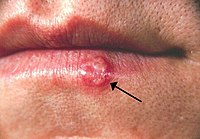
Photo from wikipedia
Abstract Objective: This study aimed to explore the temporal trend in congenital syphilis, according to sociodemographic and prenatal care in the city of São Gonçalo – Rio de Janeiro, from… Click to show full abstract
Abstract Objective: This study aimed to explore the temporal trend in congenital syphilis, according to sociodemographic and prenatal care in the city of São Gonçalo – Rio de Janeiro, from 2007 to 2018. Methods: Ecological time series study, with data from SINAN (Information System for Notifiable Diseases) and SINASC (Information System on Live Births databases). We calculated annual incidence (per 1,000 live births) according to sociodemographic and prenatal variables. For the same variables, we calculated trends by logarithmic regression (Joinpoint Regression), estimating the annual percentage change. Results: A total of 2,420 cases were reported from 2007 to 2018, with an increasing trend: 64.9% per year (2010–2013) and 24.9% (2013–2018). In 2018, the highest rates were in adolescents (90.6/1,000 live births), black women (87.6/1,000 live births), low-educated women (122.8/1,000 live births), and those without prenatal care (677.4/1,000 live births). The annual percentage change of these categories was, respectively, 37.3% (2010–2018), 33.5% (2012–2018), 39.9% (2014–2018), and 85.0% (2011–2015), but all categories showed a crescent trend. Conclusions: We identified high congenital syphilis incidences and crescent trends, especially in more vulnerable groups, pointing to social and healthcare inequalities. Prenatal care needs to be more comprehensive and qualified, primarily for young, low-educated, and black women.
Journal Title: Revista Paulista de Pediatria
Year Published: 2023
Link to full text (if available)
Share on Social Media: Sign Up to like & get
recommendations!